 “Who’s afraid of the Big Bad Wolf, Big Bad Wolf, Big Bad Wolf?” This week’s breakdown features a true Disney triumph.
“Who’s afraid of the Big Bad Wolf, Big Bad Wolf, Big Bad Wolf?” This week’s breakdown features a true Disney triumph.
Walt Disney’s wife Lillian and her sister Hazel Sewell, head of the studio’s inking and painting department, suggested this familiar story as a potential Silly Symphony. By mid-December, 1932, gag meetings were conducted and a three-page outline circulated around the studio. During this period, the studio’s four principal story artists were Webb Smith, Ted Sears, Pinto Colvig, and Albert Hurter.
The original source material has the wolf devour the first two pigs after blowing their houses down. After failing to blow down the diligent third pig’s brick house, the wolf climbs down the chimney, but the third pig catches and traps the wolf in a boiling cauldron, eating him in the end. Naturally, these components are omitted in the film, but the wolf’s intent to eat the pigs is still retained. In order to give these characters appeal, Disney wanted the pigs to be portrayed as human characters, dressed in clothes; they also acquired household tools and musical instruments in certain sequences. Albert Hurter, hired at the studio in June 1931, designed the giddy pigs, their costumes and their houses.
Two freelance singers, Dorothy Compton and Mary Moder, provided the voices for The Fifer Pig and Fiddler Pig, while Pinto Colvig provided the voice for the Practical Pig. Moder recalled their session on Three Little Pigs as a simple one-day assignment, in between their other recording work. Both were paid ten dollars each for their days’ work. For the deep, gruff voice of the Big Bad Wolf, Colvig advised screen comedian Billy Bletcher, whom he knew from working as a gag writer at Mack Sennett’s studio, to audition for the role.

Bletcher already was a busy comic actor, starting at the Vitagraph Studios in Brooklyn, moving over to the Vim Comedy Company in the teens, appearing in several of the Plump and Runt comedies, starring Oliver Hardy and Billy Ruge. For a brief period in 1920-21, he worked under the name Billy Fletcher, acting in short comedies such as Al Christie’s Gayety Comedies, Spotlight Comedies, Universal Comedies, Mack Sennett, Hal Roach, and Columbia Pictures, among many. Bletcher’s performance of the Big Bad Wolf led to many performances of different characters, especially animated villains, for Disney and other animation studios.
Animation for Three Little Pigs was underway by mid-February, 1933. Much of the scenes are handled by two of the studio’s strongest animators, Norm Ferguson and Dick Lundy. Newer, advanced artists Fred Moore and Art Babbitt animated much of the remainder. Jack King animates a few brief sequences of the Practical Pig sitting at his piano. For this cartoon, these animators are cast by character; Lundy and Moore are assigned sequences of the pigs, while Ferguson and Babbitt animated scenes of the Big Bad Wolf. (Moore animates a small number of scenes with the wolf, as well.)
 Fred Moore, who started at the studio in August, 1930 at the age of 19, rose to prominence as an animator. He developed an integral attitude of the characters’ bodies as they followed through with the actions. “Squash-and-stretch,” as it became known, meant the volume, and the curved forms, of the pigs’ bodies remained consistent as they altered shape by the force of pulling or pushing.
Fred Moore, who started at the studio in August, 1930 at the age of 19, rose to prominence as an animator. He developed an integral attitude of the characters’ bodies as they followed through with the actions. “Squash-and-stretch,” as it became known, meant the volume, and the curved forms, of the pigs’ bodies remained consistent as they altered shape by the force of pulling or pushing.
Moore’s introductory scenes as the Fifer, Fiddler and Practical Pig attested to these new methods of flexibility in character animation. This impressed his fellow colleagues, and Walt Disney himself; it proved so influential that other animation studios proceeded to implement “squash-and-stretch,” rendering rubber-hose animation, begun in the late teens, almost archaic. However, studios such as Max Fleischer’s and Ub Iwerks’ still continued to utilize them to their unique styles.
Art Babbitt’s drawings/animation of the Big Bad Wolf appear more sinister and wolf-like than Ferguson’s. Having arrived from Paul Terry’s studio in New York a few months before, traces from his earlier animation hadn’t withdrawn— the Wolf bears some resemblance to villainous characters in the contemporary Terrytoons. As in Moore’s animation, Babbitt’s employed fundamental aspects towards the pigs’ bodies. In one sequence, the objects in the Practical Pig’s house have real weight— he struggles to lift up the lid of a pot and bring over a can of turpentine.
Burt Gillett, the director of Three Little Pigs, previously worked in almost all of the major New York animation studios throughout the late teens and 1920s. These included Barre-Bowers (run by Raoul Barre and Charley Bowers), International Film Service, Bray Studios, Max Fleischer, Associated Animators and Pat Sullivan before being hired by Disney on April 13, 1929.

Shortly after his arrival, Gillett became the main director of the Mickey Mouse cartoons. Disney and Ub Iwerks took on supervisory roles, as the staff and production schedule increased. He directed several Silly Symphonies after Iwerks left the studio, including the early Technicolor entries. According to some accounts, Gillett was an energetic director, using his entire body— even jumping from his desk down to the floor—to explain different actions to his animators, with a musical composer accompanying him on piano.
In the outline for Three Little Pigs, Disney suggested the film could be depicted as an operetta, with singing and rhyming dialogue. This, along with the musical score by composer Frank Churchill, each integrated successfully with the action. The score is underscored with Churchill’s original song “Who’s Afraid of the Big Bad Wolf?” which is never played fully intact throughout the cartoon— it is often fragmented or obstructed by the narrative. Carl Stalling, Disney’s first musical composer, who suggested the notion of the Silly Symphonies, left Iwerks’ studio for a brief period, and returned to Disney as a freelance arranger and pianist. Stalling can be heard as the Practical Pig plays a mocking, dramatic piano vamp after each of the Wolf’s failed attempts to blow down his brick house.

Three Little Pigs premiered at the Radio City Music Hall in New York on May 27, 1933. It received a sensational public response as it was shown in neighborhood theaters, becoming the most phenomenal short cartoon of its time.
Some venues ran the film for such long runs that hand-drawn beards were added to marquees and one-sheet posters. Released during the middle of the Great Depression, “Who’s Afraid of the Big Bad Wolf?” became a national symbol for Americans to rally against the fear and threat of poverty.
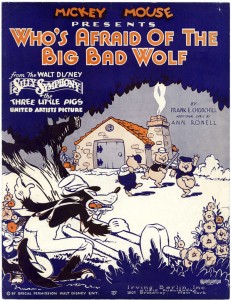 The success of Disney’s first smash hit surprised him—customers in music stores clamored for sheet music of the song, but none had been prepared. Disney sent his musicians to the theater to copy the words and music from the screen to rectify these demands. The popularity of Pigs generated a large amount of merchandising, which included storybooks, figurines soap, watches, sand buckets, and sprinkling cans, among countless others. It became the first film to return a higher gross in merchandising royalties than its box office reception.
The success of Disney’s first smash hit surprised him—customers in music stores clamored for sheet music of the song, but none had been prepared. Disney sent his musicians to the theater to copy the words and music from the screen to rectify these demands. The popularity of Pigs generated a large amount of merchandising, which included storybooks, figurines soap, watches, sand buckets, and sprinkling cans, among countless others. It became the first film to return a higher gross in merchandising royalties than its box office reception.
Three Little Pigs received the Academy Award for Best Animated Short.
Theater owners asked Disney if he would make another short with the Three Little Pigs; he reportedly answered, “You can’t top pigs with pigs.” However, three sequels were produced after: The Big Bad Wolf (1934), Three Little Wolves (1936), and The Practical Pig (1939).
Pigs inspired animators who arrived at Disney’s after its release; Ward Kimball, Milt Kahl and Marc Davis were among the few intrigued by the film when they saw it in theaters. Chuck Jones, an animator at Warners at the time, recalled in an interview during Pigs’ success: “Most of us felt that, there was Disney and here were the rest of us, just hacking away at the edges. We didn’t consider ourselves in the same league.”
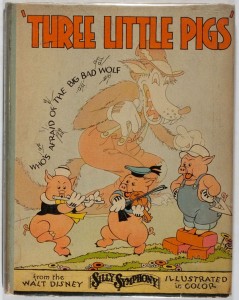 In the wake of this cartoon’s success, Burt Gillett couldn’t create a suitable follow-up for the studio, which brought harsh criticism from Disney. The Van Beuren studio needed an upgrade in the quality of their cartoons, which were receiving tepid reviews—its distributor, RKO, sought box office appeal. Due to the popularity of Pigs, the studio induced Gillett to take charge of the operation. He left Disney’s by April, 1934.
In the wake of this cartoon’s success, Burt Gillett couldn’t create a suitable follow-up for the studio, which brought harsh criticism from Disney. The Van Beuren studio needed an upgrade in the quality of their cartoons, which were receiving tepid reviews—its distributor, RKO, sought box office appeal. Due to the popularity of Pigs, the studio induced Gillett to take charge of the operation. He left Disney’s by April, 1934.
Whatever success Pigs had in its release, social attitudes changed by the time the film was to be re-issued in the late ‘40s. The Hayes Office demanded the sequence where the Wolf is disguised as a Jewish door-to-door brush salesman, be revised to omit the stereotypical aspects of his voice and disguise. The first revision was made in September 1947, by director Jack Hannah, and kept the original dialogue track. Later, the soundtrack was also revised, with the Wolf’s second line of dialogue changed to, “I’m working my way through college.” Home video releases have different versions—the videocassette and laserdisc releases retain the original animation, but kept the revised dialogue track. The American DVD release of Walt Disney Treasures uses the revised version, with the alternate dialogue. (The European release of the same set uses the same version as the earlier home video copies.) The correct dialogue track from the original 1933 release, sourced from a CD compilation of Disney songs, is reinstated here in the breakdown video.
Enjoy!

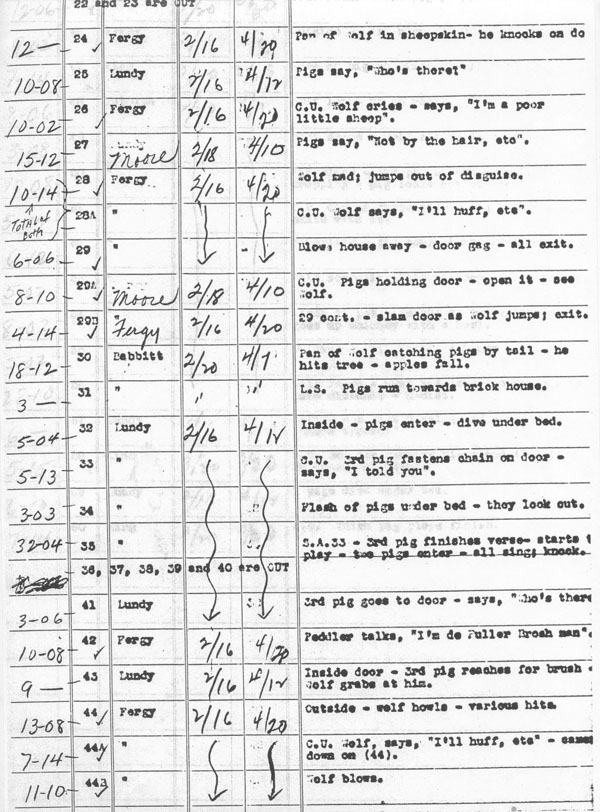
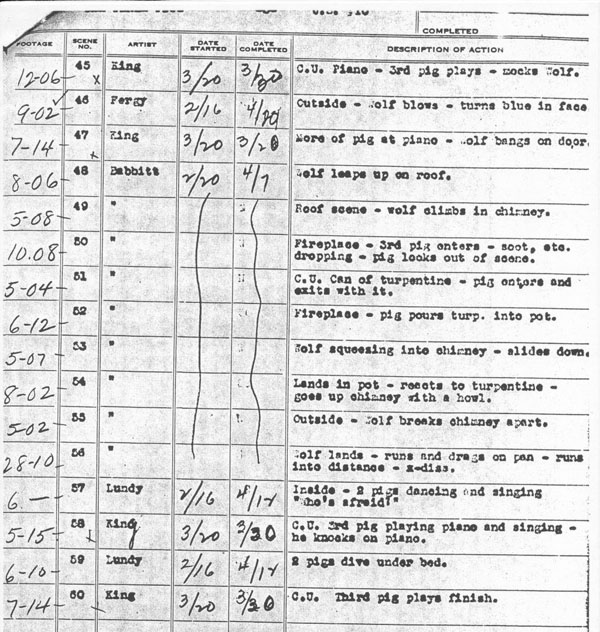

(Thanks to Mark Kausler, Michael Barrier, J.B. Kaufman and Steve Massa for their help.)


 DEVON BAXTER is a film restoration artist, video editor, and animation researcher/writer currently residing in Pennsylvania. He also hosts a
DEVON BAXTER is a film restoration artist, video editor, and animation researcher/writer currently residing in Pennsylvania. He also hosts a 
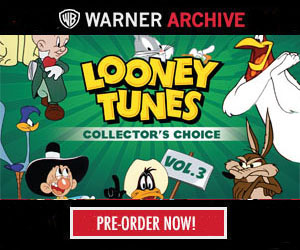


















































































The Three Little Pigs has three sequels one featuring Little Red Riding Hood, one with the Little Bad Wolves who were the nephews of Big Bad Wolf and The Practical Pig as well as a WWII Propaganda film for Canada’s Savings Bond drive.
The Three Little Pigs made a special appearance on the Mexican biography film Cri Cri singing Who’s Afraid of the Big Bad Wolf in Spanish.
Devon:
Thanks for including the original version of this Disney classic toon as Burt Gillett and his crew intended it to be seen.The chane in dialogue “I’m working me way through college” sounded a bit strained, but I guess when you’re dealing with the likes of the Hays Office (and,as you mentioned,chamging social attitudes),it’s a little difficult to adjust.It’s too bad that Gillett couldn’t come up with a suitable sequel,although Disney was able to do variations on the idea later in THE PRACTICAL PIG and THREE LITTLE WOLVES.I thoughly enjoy your weekly breakdowns!
When did the Big Bad Wolf’s son first become a “good bad wolf” in the comic strips?
In the new hit Disney Junior series Goldie & Bear the Three Little Pigs are siblings which two of the. are brothers and the third member is a sister. And the Big Bad Wolf is more like a prankster than evil and he has a brother known as The Big Good Wolf.
“Walt Disney’s Comics & Stories” #52 (1945).
As I heard the wolf utter the lines “I’m a poor little sheep with no place to sleep…”, I was reminded that the line was paraphrased or reused for a cartoon from another studio. Please correct my error here if I’m not right, but I believe now that the line was reused in the PORKY PIG cartoon, “LITTLE BEAU PORKY” from Frank Tashlin for Warner Brothers and it is possible that the voices of the first two pigs also appeared somewhere within the HAPPY HARMONIES series. It’s interesting that theater owners would clamor for the SILLY SYMPHONIES series to reprise their characters, but I guess that was the name of the game. To me, the SILLY SYMPHONIES were perhaps Disney’s greatest achievement in short cartoons *BECAUSE* they didn’t repeat characters, not that the rare instances of repeated characters were horrible efforts (the other instance that I know of being Tobey Tortoise and Max Hare). I just liked the idea of one shot cartoons because those were good ways to try out new things like characters or new animation techniques that might not work with established characters. Oh, and thanks for finally allowing me to hear the original soundtrack on this cartoon. I missed the single-sided laserdisc that featured the three BIG BAD WOLF cartoons. I just felt that it didn’t have enough material on it; little did I know that it had one small collectable “gag” that would be omitted as quickly as it surfaced.
In my top 5ive favorite films!! Thank YOU!!!!
I remember seeing clips of this as a kid and the wolf burning in water scared me…….
I saw it years later after Nightline did a section on cartoon censorship and showed the clip of the Jewish Wolf disguise and wanted to download the “uncensored” version on my iPod.
What distinguishes THE THREE LITTLE PIGS from a great deal of the 1930s Disney shorts is: 1) it’s funny and 2) it has a coherent storyline, built on gags and solidly established personality of the characters. I know this is heresy in some animation circles, but what bores me about many Disney cartoons is the lack of either element–especially a sense of story cohesion.
This cartoon was kind of a fluke for Disney. The harder edge of its humor was subsumed by the ooh-ahh visuals and tenuous narratives that often lack consequences. This is true of Disney cartoons I love, such as BROKEN TOYS, and in some cases it works nonetheless. Too often, I leave a Disney cartoon feeling malnourished. I’ve seen a lot of pretty pictures, but I haven’t had anything of substance. This, and a handful of other ’30s Disney cartoons, is nourishing.
The one drawback to THE THREE LITTLE PIGS was the numerous crappy cartoons that came in its wake. Every studio felt obliged to imitate its basic story, and that led to all the living-toys-goose-the-spider-with-an-eggbeater films that make 1935-1940 animation such tough going. It was a major setback in the progress of animated cartoons. Humor went out the door, replaced by rote melodrama and a stale, lifeless feel that it took the Schlesinger boys to shake out of animation’s DNA.
Devon thanks for all your terrific work each week.
I LOVED today’s piece because I have previously written about the same film in 2007 under my “Wade Sampson” pseudonym when my Disney University manager wouldn’t allow me to use my real name when I was working at WDW. Here is the link to the article: https://www.mouseplanet.com/8198/Disneys_Ham_Actors_The_Three_Little_Pigs
Supposedly, Walt told Moore about this big pig he used to ride into the mudhole back on the Marceline farm and its distinct personality to help Moore understand that pigs have individual personalities.
I’ve heard that Walt didn’t come up with the famous “can’t top pigs” until AFTER the sequels were released and were flat at the box office.
Jack Hannah told me it was his crew that did the reanimation to make the wolf a gentile Fuller Brush salesman.
And, of course, the pigs were so popular that live action versions appeared in the Laurel and Hardy movie based on Babes In Toyland (aka “March of the Wooden Soldiers”).
Even if Walt couldn’t “top pigs with pigs” at least he didn’t cut the budgets on subsequent ones, like the 1990s/2000s DTV sequels compared to their respective originals.
Ironically, Jim, THREE LITTLE WOLVES is my absolute favorite out of all the “pigs” films.
I’ve never seen the original model sheets for this cartoon. I hope they’ll be in J. B. Kaufman’s Silly Symphonies book.
Re the “peddler” scene, I have notoced that while the dialogue may have been redubbed, the music in that scene is still a sort of minor-key, klezmer-like tune that sounds “Jewish.”
That scene has often been pointed at as prime “evidence” that proves “Walt Disney was an anti-Semite.” Of course, just about every other animation studio of that era did at least a couple of cartoons with Jewish-stereotype characters, often even more extreme than this. Probably the most egregious one I’ve seen is in “Betty Boop’s Ups and Downs,” and it should be noted that the studio that produced it, Fleischer, was owned and managed by Jews.
Watch some early B&W Van Beurens sometime — those are even more egregious, considering the fact is that the payoff is that a certain character IS Jewish, and nothing more.
Can anyone tell me if “The Practical Pig” is on a Disney DVD set? The title is listed in the paper program of one of the Silly Symphony sets (Volume 1?), but the title is not to be found on the DVD menu, nor can I find in any of the Easter eggs.
After viewing this, I think Art Babbit’s scenes were the strongest in terms of appeal and animation.
Also, for the first time I have wondered what a brick piano would really sound like.
I think they use a brick piano to create “Walls Of Sound” but I’m just Specter-ulating. Nyuk, nyuk.
How many times was that Fuller Brush salesman gag reanimated? I remember with the accent but he only had a beard, not big nose and mask. I’m unsure of another…maybe it was an illustration in a Disney book with a beard and fake nose. And then another where he sounds dumb,”I’m working my way through college”. And retraced as a Nazi …somewhere in my memory.
Dan Lega, “Practical Pig” appears on Disc 1 of Silly Symphonies Vol. 1, which was in the first wave of the late lamented Walt Disney Treasures 2-disc tin sets.
This was found over at Yowp’s Tralfaz blog, a quote from Variety:
June 22, 1955
Songwriter Ann Ronell filed a $90,000 damage suit against Walt Disney Productions in New York Federal Court last week, claiming that Disney had neglected to give her writer’s credit on the “Who’s Afraid of the Big Bad Wolf” song when the filmed story of its creation was shown on Ed Sullivan’s “Toast of the Town” in January of 1954 and again on “Disneyland” in February of this year.
Miss Ronell claims she’s currently negotiating on the story of her life for motion pictures and tv, and failure by Disney to give her credit on the song is detrimental to those negotiations. Miss Ronell claims the song was sub-licensed by Irving Berlin’s music firm for use in the “Big Bad Wolf” cartoon, and in the subsequent tv showings that “gave credit to others,” she was “maliciously hurt and injured.”
The first VHS release (the “More of Disney’s Best” tape from 1984) has the revised animation. It’s the “Favorite Stories” VHS and laser from 1996 that has the original picture element and mismatched audio.
I read that the Anti-Defamation League complained to Disney about the ’96 release, which is probably why the American Treasures DVD has the reanimated wolf.
I remember watching an interview with Leonard Maltin- and he claimed the decision to use the re-animated version of the scene was something he made himself. Since it was part of the first wave of Disney Treasures DVDs, he was concerned that a caricature that extreme would turn audiences off the series. He has since said he regretted that decision.
My favorite part of the cartoon? The pictures on the wall of the Practical Pig’s brick house. One has a sow feeding several pigs that’s labeled “Mother.” The other has a string of sausages labeled “Father.”
Oh, and the picture over the bed of the football labeled “Uncle Otto.”
I tried for a couple years to get access to the production documents for this cartoon, without success. It’s great to see them here. Are you aware that some of the image links are broken? Any chance of fixing that? I’d like to see them. Thank you.
On a budget of $22,000, this short grossed around $250,000 in total, which was unheard of for an animated short.
I can’t thank you all enough for taking the care and time to put these articles together. I’m constantly backfilling any cartoon/film history I missed in college in the 90s – and there’s a lot, because back then animation was taught as a trade, with no thorough history courses about the medium. With ppl like yourselves putting such quality writing together, research is such a delight, and it alleviates so much shelf space in my office! Just wonderful work.
Comparision bettween the original 1933 an 1948 Jews peddler sequences: https://www.youtube.com/watch?v=mC9V9GkoiSg
Correct me if I’m wrong- but I thought the decision to re-animate the Jewish peddler scene was made by Walt himself with no outside pressure. At least that’s what I read on Jim Korkis’ website… although I could be wrong.